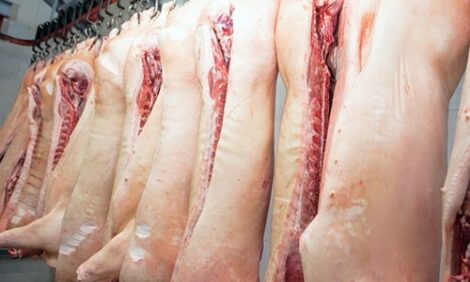



Hogs & Pigs Report: Finally Some Good News
US - Economist Steve Meyer writes, "After two years in which about any light at the end of the tunnel turned out to be an oncoming freight train, pork producers have every right to be encouraged by the USDA’s Quarterly Hogs and Pigs report issued last Friday."Table 1 contains the key data from Friday’s report and readers can see from the right-most column that every number except one (the 180 lb. and over inventory) was smaller than analysts expected. It’s not that analysts are always right, but their pre-report opinions are meant to measure the changes that are already “in the market” – especially the futures market. These relatively large deviations imply strong Lean Hogs futures prices on Monday – most likely limit up at some point during the day. That conclusion applies more strongly to the deferred contracts where the impacts of a 2.4 per cent smaller December-February pig crop might be more greatly felt.

As for the “smell” tests, this report is okay, but not great. The year-on-year change in the 180-lb. plus inventory (-1.1 per cent) agrees almost precisely with March slaughter through last Saturday (-1 per cent). The problem, if there is one, lies in the comparison of the December-February pig crop (-2.4 per cent) to the under-50 lb. number (-4 per cent). January-February weaner/feeder pig imports from Canada were 3.1 per cent lower (about 25,000 head) than last year. That number is far too small to explain the difference between the pig crop and the lightweight inventory estimate. Pigs from this group will begin to come to market in June, so we will not have a good test for which number is closer to correct until then.
The report also indicates that the rapid productivity increases witnessed over the past two years may be slowing a bit. Reductions in farrowings and farrowing intentions were larger than anticipated, but are very much in line with the change in the breeding herd. The growth rate of average pigs saved per litter fell all the way (I’m being facetious) to 1.4 per cent vs. one year ago. That still leaves the average growth rate for the past two years at 2.15 per cent, the last three years at 2.08 per cent, but it does mark the first quarter with under 2 per cent year-on-year growth since the December 2007-February 2008 quarter. See Figure 1.

Figure 1 also shows the normal seasonal pattern of litter size growth picking up in the Mar-May quarter, and peaking in June-August. It will be interesting to see if that happens this year, given the difficulty we have seen with molds and toxins in corn. While producers have no doubt been careful about the corn they use in sow diets, one would expect some impact on productivity. Will it come in farrowings/breeding animal or pigs/litter? Regardless, any negative impact adds to the positive impact of this report on market prices.
Significant Supply Shift
These numbers change the supply outlook for 2010 pretty dramatically. The December report indicated modest reductions in Q1 and Q2 slaughter that actually tapered off in the second half of the year. As Figure 2 shows, this report indicates that the reductions will get larger as we progress through the summer and early fall before declining in December. When lower numbers of Canadian feeder pigs are factored in, this report says that slaughter will be down 4 to 4.5 per cent from June through September. Any semblance of a normal summer and, thus, a normal market weight decline, could take another 1-2 per cent off of pork supplies compared to last summer’s big hog-bloated total.

Talking about a 5 per cent pork production decrease is something akin to speculating on a Chicago Cubs World Series championship – it just does not happen very often! Year-over-year pork production has fallen by 5 per cent or more in only 30 of the 582 weeks since 1 January 2001. Four of those weeks were between 26 December 2009 and 30 January 2010, and two of them were last summer when packers cried “uncle” over record low margins and slowed chain speeds or idled plants to push cutout values higher, which thereby created a major positive turning point for the hog market.
So 20 per cent of the historical weeks with 5 per cent or greater reductions have occurred in the past nine months and I doubt the tally is over. The long-predicted, long-anticipated reduction of pork supplies that simply had to happen to cover a quantum increase in costs is finally here. I just hope nothing goofy happens on the demand side to mess up the party. All of you deserve one!
Table 2 shows my price forecasts, as well as those of the University of Missouri, Iowa State University and the Livestock Marketing Information Centre. It is important to note that the futures prices in Table 2 are from Friday, 26 March. Chicago Mercantile Exchange Lean Hogs April futures are roughly $2 higher and the remainder of the 2010 contracts are up the $3/cwt. daily limit as of 10:40 a.m. yesterday, Monday, 29 March.

Further Reading
| - | You can view the USDA Quarterly Hogs & Pigs Report by clicking here. |








